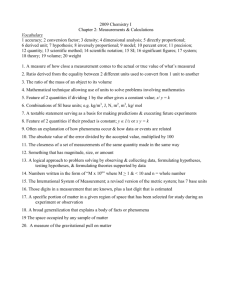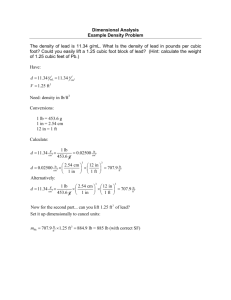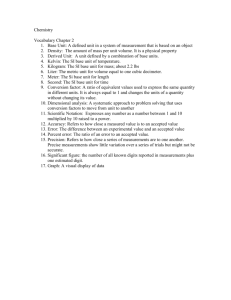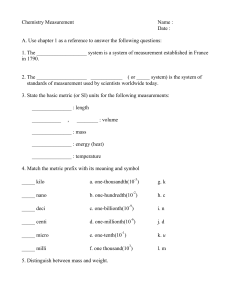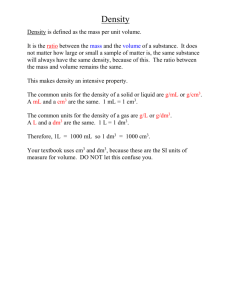silbchp1
advertisement
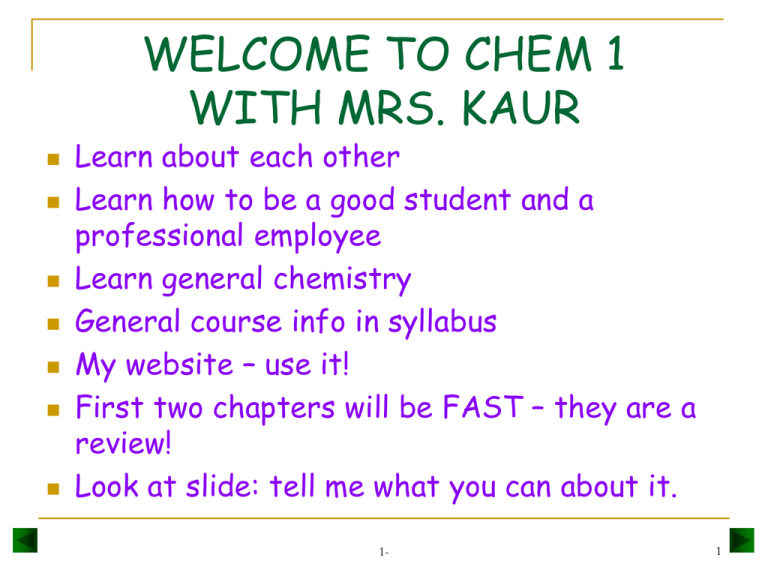
WELCOME TO CHEM 1 WITH MRS. KAUR Learn about each other Learn how to be a good student and a professional employee Learn general chemistry General course info in syllabus My website – use it! First two chapters will be FAST – they are a review! Look at slide: tell me what you can about it. 1- 1 Tell me all you can about this picture: 1- 2 Chapter 1 Keys to the Study of Chemistry 1- 3 HOW TO LEARN CHEMISTRY? Think of it as a foreign language Memorize the new words, names of elements and compounds, definitions Use flash cards Learn how to be a scientist Also question everything you read or hear - even me or the textbooks. Scientific exploration begins with questions, and leads to more questions. Read “Study tips and how to take a test” in your packet of handouts. 1- 4 Is the study of matter, its properties, the changes that matter undergoes, and the energy associated with these changes. 1- 5 Definitions Matter anything that has mass and volume -the “stuff” of the universe: books, planets, trees, professors, students Composition the types and amounts of simpler substances that make up a sample of matter Properties the characteristics that give each substance a unique identity Physical Properties Chemical Properties those which the substance shows by itself without interacting with another substance such as color, melting point, boiling point, density those which the substance shows as it interacts with, or transforms into, other substances such as flammability, corrosiveness 1- 6 Figure 1.1 The distinction between physical and chemical change. A Physical change B Chemical change 1- 7 Table 1.1 (4th ed.) Some Characteristic Properties of Copper Physical Properties Chemical Properties slowly forms a basic blue-green sulfate in moist air reddish brown, metallic luster easily shaped into sheets (malleable) and wires (ductile) reacts with nitric acid and sulfuric acid good conductor of heat and electricity density = 8.95 g/cm3 slowly form a deep-blue solution in aqueous ammonia melting point = 10830C boiling point = 25700C 1- 8 Figure 1.2 The physical states of matter. What are the phase changes? There are six - see how many you can remember… 1- 9 REVIEW OF DEFINITIONS YOU SHOULD ALREADY KNOW: Phases of matter: solid, liquid, and gas, and phase changes between them Solutions of matter: s, l or g mixtures. Solute dissolved in a solvent = a solution. Physical properties and chemical properties (see previous slides) Extensive vs. Intensive properties Separation processes 1- 10 Sample Problem 1.2 Distinguishing Between Physical and Chemical Change PROBLEM: Decide whether each of the following process is primarily a physical or a chemical change, and explain briefly: (a) Frost forms as the temperature drops on a humid winter night. (b) A cornstalk grows from a seed that is watered and fertilized. (c) Dynamite explodes to form a mixture of gases. (d) Perspiration evaporates when you relax after jogging. (e) A silver fork tarnishes slowly in air. SOLUTION: (a) physical change (b) chemical change (d) physical change (c) chemical change (e) chemical change 1- 11 Energy is the capacity to do work. Potential Energy Nonpotential Energy Energy due to the position of the object or energy from a potential chemical reaction Energy due to the motion of the object E=1/2 mv2 Heat transfer q=mcpDT Light energy e=hn Radiant energy, blackbody radiation Etc. Potential and nonpotential energy can be interconverted. (See figure 1.3 in your textbook) 1- 12 Fig 1.4 Scientific Approach: Developing a Model Observations : Hypothesis: Natural phenomena and measured events; universally consistent ones can be stated as a natural law. Tentative proposal that explains observations. revised if experiments do not support it Experiment: Model (Theory): Procedure to test hypothesis; measures one variable at a time. Set of conceptual assumptions that explains data from accumulated experiments; predicts related phenomena. altered if predictions do not support it Further Experiment: Tests predictions based on model. 1- 13 A Systematic Approach to Solving Chemistry Problems 1. Problem statement Clarify the known and unknown. 2. Plan Suggest steps from known to unknown. Prepare a visual summary of steps. 3. Solution 4. Check 5. Comment and 6. Follow-up Problem 1- 14 SI Base Units Table 1. 1 Physical Quantity (Dimension) Unit Name Unit Abbreviation mass kilogram kg length meter m time second s temperature kelvin K electric current ampere A amount of substance mole mol luminous intensity candela cd volume liter Know the ones outlined in red.1- L 15 Table 1.2 Common Decimal Prefixes Used with SI Units Prefix Prefix Symbol Word tera giga mega kilo hecto deka ----deci centi milli micro nano pico femto T G M k h da ---d c m n p f trillion billion million thousand hundred ten one tenth hundredth thousandth millionth billionth trillionth quadrillionth Conventional Notation 1,000,000,000,000 1,000,000,000 1,000,000 1,000 100 10 1 0.1 0.01 0.001 0.000001 0.000000001 0.000000000001 0.000000000000001 Memorize these prefixes! 1- Exponential Notation 1x1012 1x109 1x106 1x103 1x102 1x101 1x100 1x10-1 1x10-2 1x10-3 1x10-6 1x10-9 1x10-12 1x10-15 16 Just for fun! Try to find out the distance from the earth to the sun in meters:_____________ Also the diameter of the helium atom:_________________ 1- 17 Common SI-English Equivalent Quantities Quantity SI Unit SI Equivalent English Equivalent Length English to 1 kilometer(km) 1000(103)m SI Equivalent Table 1.3 0.62miles(mi) 1 mi = 1.61km 1 meter(m) 1 mi = 5280 ft 100(102)cm 1000(103)mm 1.094yards(yd) 39.37inches(in) 1 yd = 3 ft, etc. 1 yd = 0.9144m 1 foot (ft) = 0.3048m 1 centimeter(cm) 0.01(10-2)m 0.3937in 1 in = 2.54cm (exactly!) 1 kilometer(km) 1000(103)m 1- 0.62mi 18 Common SI-English Equivalent Quantities Quantity SI Unit SI Equivalent English Equivalent Volume English to SI Equivalent 1 cubic meter(m3) Table 1.3 1,000,000(106) cubic centimeters 35.2cubic feet (ft3) 1 ft3 = 0.0283m3 1 cubic decimeter(dm3) 1000cm3 0.2642 gallon (gal) 1.057 quarts (qt) 1 cubic centimeter (cm3) 0.001 1 gal = 4 qt 1 gal = 3.785 dm3 1 qt = 0.9464 dm3 1 L = 1.0567 qt dm3 0.0338 fluid ounce 1 qt = 946.4 cm3 1 fluid ounce = 29.6 cm3 1- 19 Common SI-English Equivalent Quantities Quantity SI Unit SI Equivalent English Equivalent Mass English to 1 kilogram (kg) SI Equivalent 1000 grams 1 lb = 453.6 g 2,205 pounds (lb) Table 1.3 1 (lb) = 0.4536 kg 1 gram (g) 1 lb = 16 oz 1000 milligrams 0.03527 ounce(oz) 1 lb = 453.6 g 1 ounce = 28.35 g 1- 20 English-Metric Conversions to Memorize 1" = 2.54 cm exactly 1 lb = 453.6 g 1 cal = 4.184 J 1.0 L = 1.0567 qt 1.000 atm = 14.70 psi 1- 21 Practice: The O-H bond length is 95.7 pm. Convert it to nm. Convert 750 mL to L: 1- 22 Weight = mass x acceleration Metric: Newton = mass in grams x accel of gravity English: Pound = mass in slugs x accel of gravity On earth we use 1 lb = 453.6 g, even though we should use slugs! Practice: Convert 2.65 g to kg: Convert 2.65 g to mg: 1- 23 The three dimensions Length is one dimensional. Area is two-dimensional: area = length x width Units will be ft2, m2, cm2, etc. Volume is three-dimensional V = length x width x height Units will be L, mL, cm3, MEMORIZE: 1 L = 103 mL, 1 mL = 1 cm3 1- 24 Equipment measuring liquid volume: From previous lab experience, describe a graduated cylinder, a buret, a volumetric flask, and a pipette. Decide which of them would provide the most accurate volume reading. 1- 25 DENSITY Density is a physical property that represents the amount of volume a certain mass displaces D = m/V Find the mass of 250.0mL of ethanol if D = 0.789g/mL at 20C. 1- 26 Table 1.5 (4th ed.) Densities of Some Common Substances* Substance Physical State Density (g/cm3) Hydrogen Gas 0.0000899 Oxygen Gas 0.00133 Grain alcohol Liquid 0. 789 Water Liquid 0.998 Table salt Solid 2.16 Aluminum Solid 2.70 Lead Solid 11.3 Gold Solid 19.3 *At room temperature(200C) and normal atmospheric pressure(1atm). 27 1- Figure 1.6 The freezing and boiling points of water. 1- 28 Temperature Scales and Interconversions Kelvin ( K ) - The “Absolute temperature scale” begins at absolute zero and only has positive values. Celsius ( oC ) - The temperature scale used by science, formally called centigrade, most commonly used scale around the world; water freezes at 0oC, and boils at 100oC. Fahrenheit ( oF ) - Commonly used scale in the U.S. for our weather reports; water freezes at 32oF and boils at 212oF. K = oC + 273.15 oC = K - 273.15 oF = 1.8 oC + 32 oC = [oF - 32 ]/ 1.8 Memorize these!!! 1- 29 TEMPERATURE CALCULATIONS Convert room temperature of 72.0oF to oC and to Kelvin. Apply sig fig rules of math. (Do you remember them?) In the northeast, we say “below zero” for very cold temperatures, but this is referring to Fahrenheit. What is “five below zero” in Celsius? 1- 30 PERCENT CALCULATIONS Percent: can be by mass or by some other measurement. Percent = part/whole * 100 If a 17.6 g silver bracelet is only 14.1 g Ag, because it is in an alloy with copper for strengthening. What is the percent-mass Ag? And the percent-mass Cu? 1- 31 Figure 1.7 The number of significant figures in a measurement depends upon the measuring device. 32.330C 32.30C The last digit, shaded gray, is the estimated digit that you would read. It is the digit with some uncertainty. 1- 32 Rules for Determining Which Digits are Significant:* All digits are significant except zeros that are used only to position the decimal point. •Make sure that the measured quantity has a decimal point. •Start at the left of the number and move right until you reach the first nonzero digit. •Count that digit and every digit to its right as significant. Zeros that end a number and lie either after or before the decimal point are significant; thus 1.030 ml has four significant figures, and 5300. L has four significant figures also. Numbers such as 5300 L are assumed to only have 2 significant figures. A terminal decimal point is often used to clarify the situation, but scientific notation is the best! *See informational handout “The Rules of Significant Figures” 1- 33 Rules for Significant Figures in Calculations 1. For addition and subtraction. The answer has the same number of decimal places as there are in the measurement with the fewest decimal places. Example: adding two volumes 83.5 mL + 23.28 mL 106.78 mL = 106.8 mL Example: subtracting two volumes 865.9 mL - 2.8121 mL 863.0879 mL = 863.1 mL 1- 34 Rules for Significant Figures in Answers 2. For multiplication and division. The number with the least certainty limits the certainty of the result. Therefore, the answer contains the same number of significant figures as there are in the measurement with the fewest significant figures. Multiply the following numbers: 9.2 cm x 6.8 cm x 0.3744 cm = 23.4225 cm3 = 23 cm3 1- 35 Rules for Rounding Off Numbers 1. If the digit removed is greater than or equal to 5, the preceding number increases by 1. 5.379 rounds to 5.38 if three significant figures are retained and to 5.4 if two significant figures are retained. 2. If the digit removed is less than 5, the preceding number is unchanged. 0.2413 rounds to 0.241 if three significant figures are retained and to 0.24 if two significant figures are retained. Be sure to carry two or more additional significant figures through a multi-step calculation and round off only the final answer. 1- 36 Practice Pair up with your lab partner or someone in your study group. Look at sample problem 1.9, sig figs and rounding. Then do its followup problem. Be prepared to show me your work. 1- 37 Precision and Accuracy Errors in Scientific Measurements Precision Refers to reproducibility or how close the measurements are to each other. Accuracy Refers to how close a measurement is to the real value. Systematic error Values that are either all higher or all lower than the actual value. Random Error In the absence of systematic error, some values that are higher and some that are lower than the actual value. 1- 38 Figure 1.8 Precision and accuracy in the laboratory. precise and accurate precise but not accurate 1- 39 Figure 1.8 Precision and accuracy in the laboratory. continued random error systematic error 1- 40

